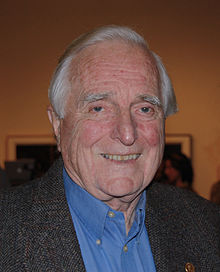Douglas Engelbart
| Douglas Engelbart | |
|---|---|

Douglas Engelbart in 2008
|
|
| Born |
January 30, 1925 Portland, Oregon, U.S. |
| Died | July 2, 2013 (aged 88) Atherton, California, U.S. |
| Residence | Atherton, California, U.S. |
| Nationality | American |
| Fields |
Human–computer interaction Inventor |
| Institutions |
SRI International, Tymshare, McDonnell Douglas, Bootstrap Institute/Alliance, The Doug Engelbart Institute |
| Alma mater |
Oregon State College (BS 1948) University of California, Berkeley (MS 1953, PhD 1955) |
| Thesis | A Study of High-Frequency Gas-Conduction Electronics in Digital Computers (1956) |
| Doctoral advisor | Paul L. Morton John R. Woodyard |
| Known for |
Computer mouse Hypertext Groupware Interactive computing |
| Influences | Vannevar Bush |
| Notable awards |
National Medal of Technology (2000), Lemelson-MIT Prize, Turing Award (1997) Lovelace Medal, Norbert Wiener Award for Social and Professional Responsibility, Computer History Museum Fellow Award (2005) |
|
Website dougengelbart |
|
| Audio | |
|---|---|
|
|
|
| Video | |
|
|
Douglas Carl Engelbart (January 30, 1925 – July 2, 2013) was an American engineer and inventor, and an early computer and Internet pioneer. He is best known for his work on founding the field of human–computer interaction, particularly while at his Augmentation Research Center Lab in SRI International, which resulted in creation of the computer mouse, and the development of hypertext, networked computers, and precursors to graphical user interfaces. These were demonstrated at The Mother of All Demos in 1968. Engelbart's Law, the observation that the intrinsic rate of human performance is exponential, is named after him.
In the early 1950s, he decided that instead of "having a steady job" – such as his position at NASA's Ames Research Center – he would focus on making the world a better place. He reasoned that because the complexity of the world's problems were increasing, and that any effort to improve the world would require the coordination of groups of people, the most effective way to solve problems was to augment human intelligence and develop ways of building collective intelligence. He believed that the computer, which was at the time thought of only as a tool for automation, would be an essential tool for future knowledge workers to solve such problems. He was a committed, vocal proponent of the development and use of computers and computer networks to help cope with the world’s increasingly urgent and complex problems. Engelbart embedded a set of organizing principles in his lab, which he termed "bootstrapping". His belief was that when human systems and tool systems were aligned, such that workers spent time "improving their tools for improving their tools" it would lead to an accelerating rate of progress.
Under Engelbart's guidance, the Augmentation Research Center developed, with funding primarily from DARPA, the NLS to demonstrate numerous technologies, most of which are now in widespread use; this included the computer mouse, bitmapped screens, hypertext; all of which were displayed at The Mother of All Demos in 1968. The lab was transferred from SRI to Tymshare in the late 1970s, which was acquired by McDonnell Douglas in 1984, and NLS was renamed Augment. At both Tymshare and McDonnell Douglas, Engelbart was limited by a lack of interest in his ideas and funding to pursue them, and retired in 1986.
...
Wikipedia
